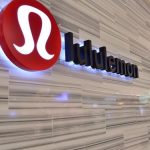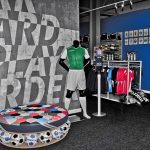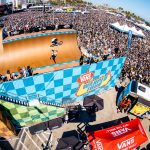Hanesbrands Inc. said it remains committed to achieving double-digit growth for diluted EPS, excluding extraordinary items, for the next three to five years. CEO Richard Noll said that a year from now, it “may narrow [its] annual EPS growth goal” to the 15% to 25% range, but for now it's maintaining a broader double-digit goal because 2008 has the potential for higher EPS growth.
“Our post-spinoff growth model is pretty straightforward,” Noll said. “Our generation of strong, consistent cash flow combined with cost-reduction efforts and modest sales growth yields significant opportunity to increase EPS.”
Since its spinoff in September 2007, Hanesbrands has repaid $285 million in debt, voluntarily contributed $96 million to its qualified pension plans, which are now 97% funded, and bought back $44 million worth of stock.
Long-Term Capital Structure
Hanesbrands has $2.3 billion of long-term debt, and the companys debt leverage, as measured by adjusted debt to EBITDAR (earnings before interest, taxes, depreciation, amortization and rent) ratio, has decreased from 5.2 at spinoff to 4.6.
The company announced today that the companys leverage goal is adjusted debt to EBITDAR of 4.0 times with a target range of between 3.5 and less than 5.0 times.
“Because of our strong cash flow due to the replenishment nature of our core categories, a leveraged profile for Hanesbrands is desirable,” said Hanesbrands Chief Financial Officer E. Lee Wyatt. “Our first priority is always to use cash to invest in our business and meet our obligations. With excess cash, we believe we have greater potential for value creation by repurchasing shares or making acquisitions than continuing to reduce our debt leverage below the 3.5 ratio.”
With the current conditions in the financial markets, Hanesbrands will maintain its current debt structure. The companys long-term debt doesnt start to mature for at least four years. When financial markets normalize, the company plans to refinance its debt.
“We will always use our cash judiciously to create value,” Wyatt said. “We are in a good position with our capital structure in todays financial market. With our current capital structure, we benefit from the declining interest rate environment, we have high liquidity and we can continue to reduce debt. When the markets normalize, we can refinance to gain greater flexibility in our use of cash, including using it to increase share repurchases and pursue potential acquisitions.”
Hanesbrands does not envision any significant commercial acquisitions with its current capital structure, although smaller tactical acquisition opportunities may be considered. Longer term, Hanesbrands would only consider acquisitions that meet strict criteria. Any acquisition would have to support its strategic initiatives, be consistent with its core business, provide synergies, complement growth, and generate returns greater than the weighted average cost of capital.
Long-Term Business Modeling Highlights
Hanesbrands follows a policy of not providing quarterly or annual EPS guidance. The company does have a practice of providing an understanding of long-term goals, trends associated with its business, current financial performance, and information required to model the long-term potential of the business.
- Increasing Sales. Hanesbrands long-term annual growth goal for sales is 1% to 3%, excluding acquisitions. The company continues to invest in its largest and strongest brands in core categories.
- Increasing Operating Profit. Hanesbrands long-term annual growth goal for non-GAAP operating profit is 6% to 8%.
- Improving Operating Profit Margin. Implicit in its long-term sales and profit goals, Hanesbrands has a goal of improving non-GAAP operating profit margins by 50 to 100 basis points per year.
- Cost-Reduction Opportunities. To support its goal of improving operating profit margins, Hanesbrands has numerous cost-reduction initiatives. Additional gross annualized savings could approach or exceed $200 million in future years. These gross savings exclude startup expenses, cost inflation, price deflation, and other cost pressures that Hanesbrands may face in future years. Any net savings would favorably impact gross margins and to a lesser extent selling, general and administrative expenses.
- Restructuring. The company expects to incur approximately $250 million in restructuring and related charges in implementing its cost-saving plan over the three-year period that began with the spinoff. About half of these charges are expected to be noncash. Through 2007, the company had recognized $116 million in restructuring and related charges.
- Working Capital. The company has a goal to continually improve working capital by an average of $50 million per year for the foreseeable future.
- Interest Expense. Three-quarters of Hanesbrands long-term debt, or $1.7 billion, benefits from a declining interest-rate environment. Based on a London Interbank Offered Rate of 3.25%, Hanesbrands has a blended interest rate of 6.9%.
- Effective Tax Rate. Due to anticipated offshore investments in its supply chain for at least the next three years, Hanesbrands expects its effective tax rate to be in the range of 22% to 25%. The rate is lower than the companys 2007 effective tax rate of 31.5%. The companys cash tax rate is expected to be no higher than half of its effective tax rate.
- Capital Expenditures. As planned, the companys capital expenditure investments were more than 30% less than depreciation and amortization for the past two years and will now exceed depreciation and amortization. Over the next three years, Hanesbrands expects to invest approximately $500 million in capital expenditures, with the highest spending in 2008. For modeling purposes, the capital spending rate after 2010 should approximate the level of depreciation and amortization.
- Use of Cash. In the current financial market, Hanesbrands will use excess cash after investing in its business to reduce debt with limited share repurchases and acquisitions. When the company refinances its debt, it may increase share repurchases or make strategic acquisitions. The company does not plan to offer a dividend at this time.
Hanesbrands is seeking to build on the successful momentum it achieved in 2007 and is focused on continuing to execute its strategies as it strives to achieve its long-term growth goals for sales, operating profit and EPS in 2008.
The consumer environment has been challenging for the past six months, but Hanesbrands achieved sales growth through brand building and retailer partnerships in 2007.
Hanesbrands business model requires only modest sales growth to create operating profit and EPS growth. The companys cash flow, cost-reduction initiatives and other business factors will be positive influences on 2008 results. Significant factors for potential EPS growth in 2008 include lower interest expense from reduced debt and lower interest rates, a lower effective tax rate and a 53rd week in the fourth quarter.
Summary of Major Initiatives
Hanesbrands is executing its strategies to build brands to drive profitable growth and to take advantage of integration and global reach to reduce costs, improve flexibility and provide high service levels.
- Brand-Building Initiatives. The company has major marketing programs under way in core categories with its strongest and largest brands, including Hanes, Champion, Playtex and Bali. The company is using these brands to advance strategic partnerships with key retailers.
- Reducing Costs and Leveraging Scale. Hanesbrands is continuing to execute consolidation of its organization and distribution network, develop its global supply chain in lower-cost countries, and seek savings from leveraging the collective size of its strategic purchasing organization.















